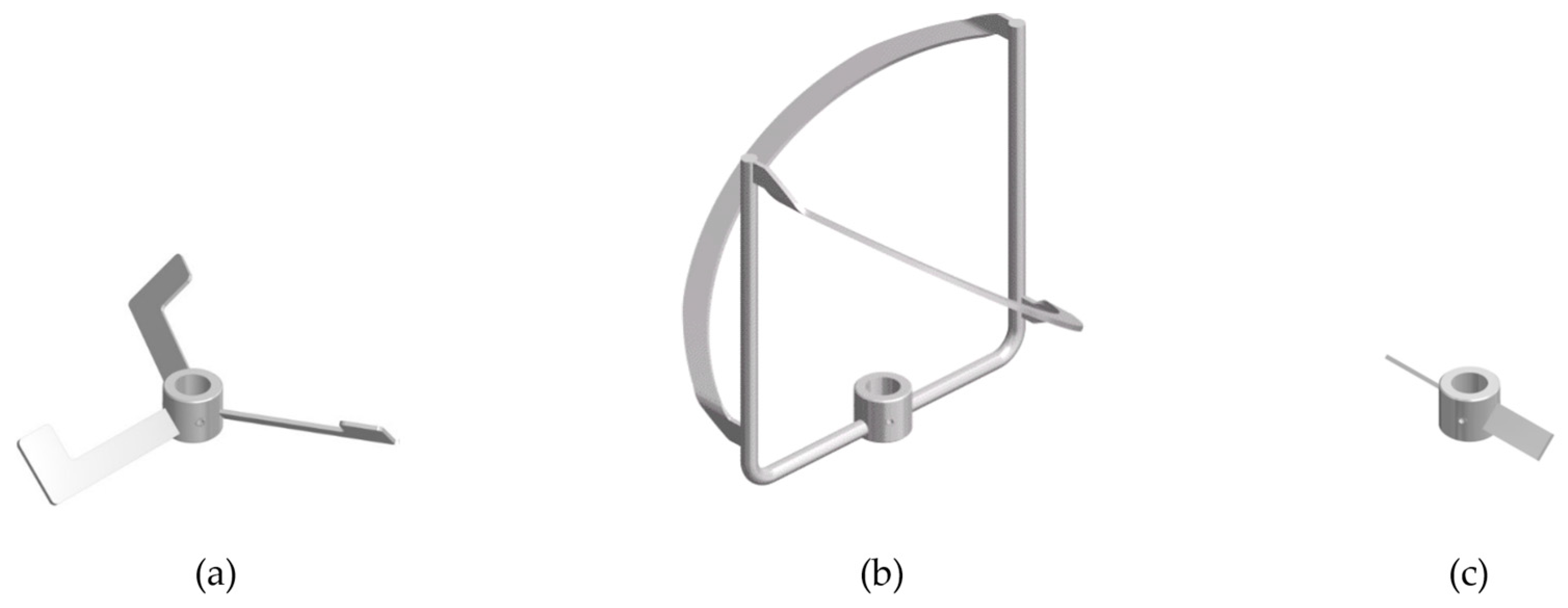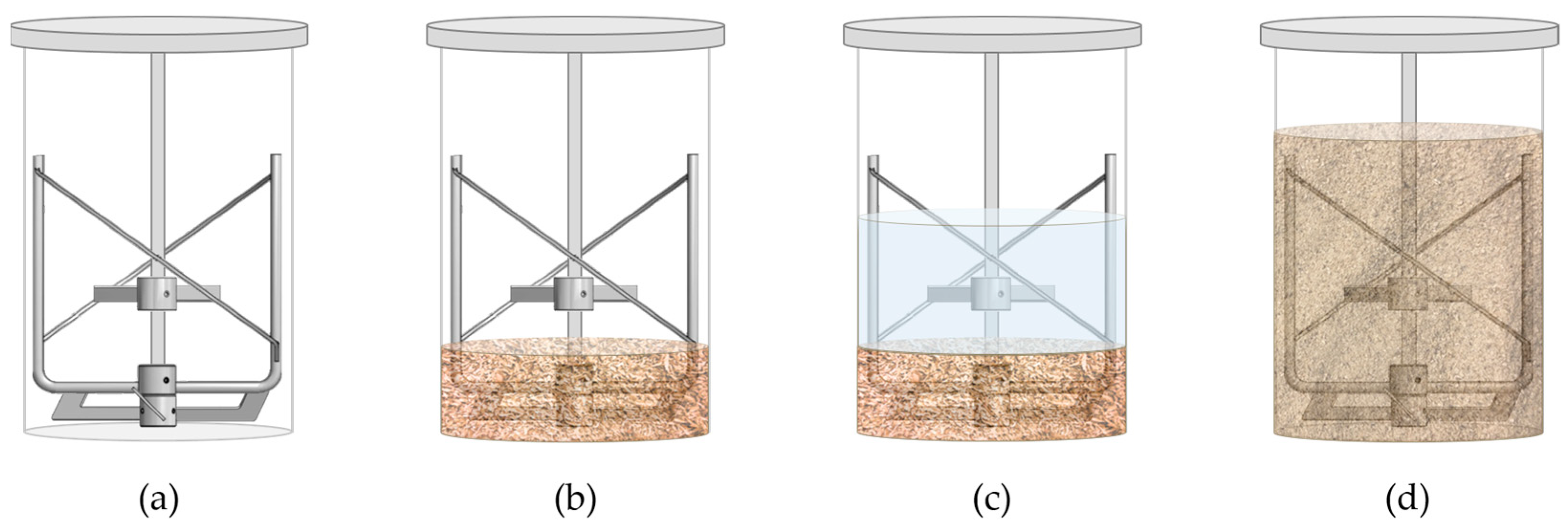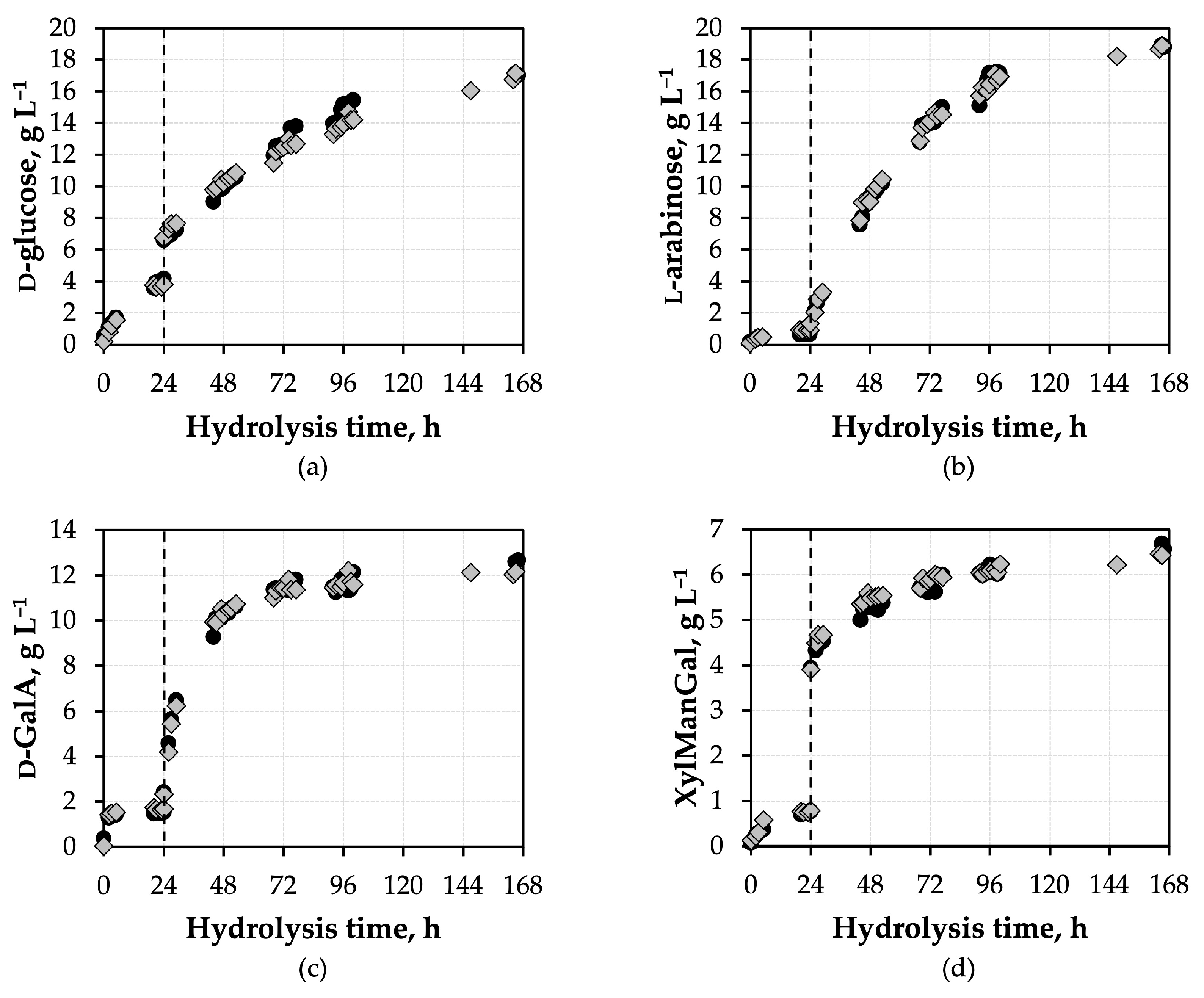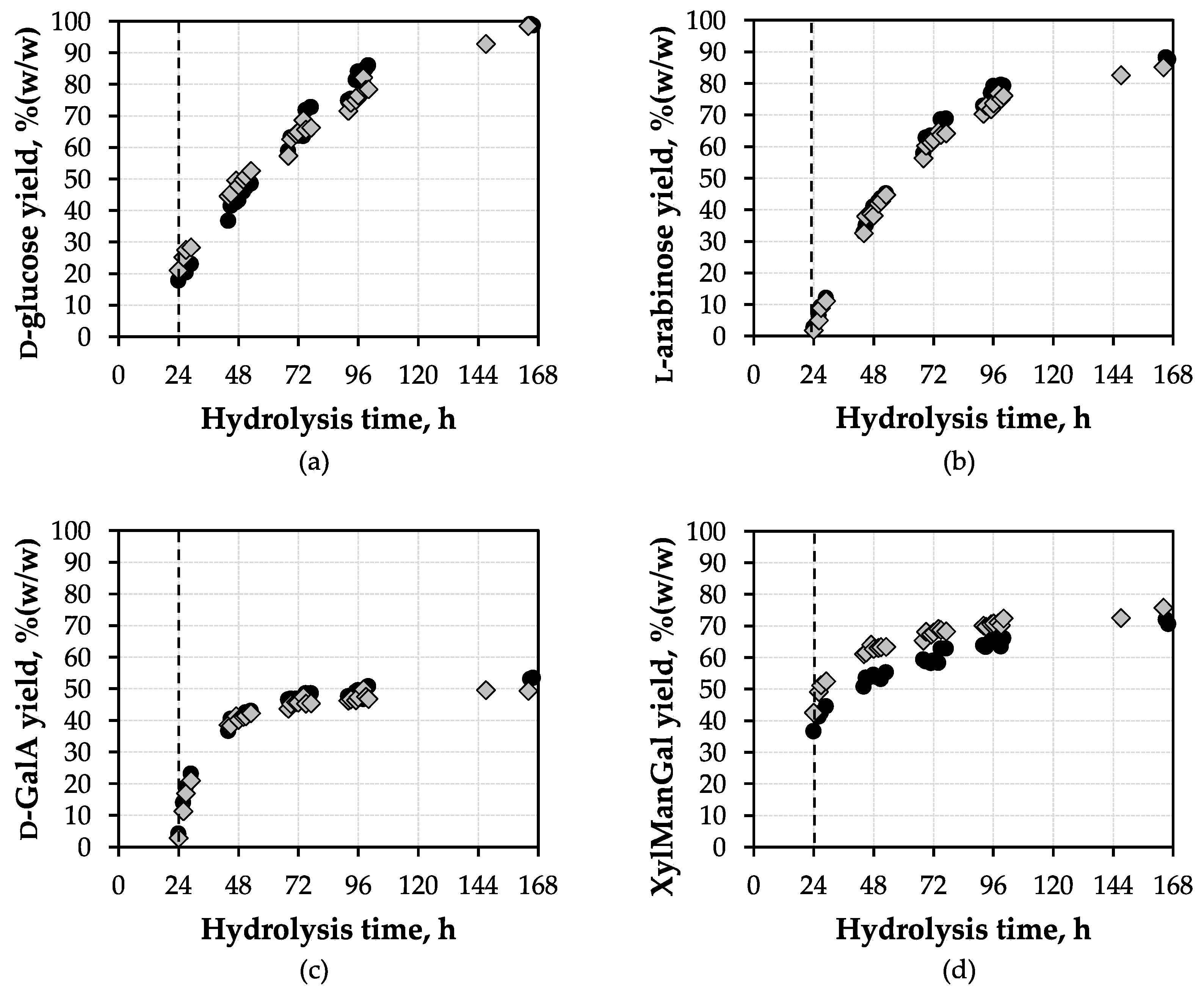Enzymatic One-Pot Hydrolysis of Extracted Sugar Beet Press Pulp after Solid-State Fermentation with an Engineered Aspergillus niger Strain
Abstract
:1. Introduction
2. Materials and Methods
2.1. Fungal Strain
2.1.1. Cloning of the A. niger gaaX Deletion Construct
2.1.2. Genetic Manipulation of A. niger
2.2. Sugar Beet Press Pulp
2.3. Sugar Beet Press Pulp Composition Analysis
2.4. Preculture, Inoculum Preparation, and Cultivation Media
2.5. Solid-State Fermentation
2.6. Subsequent Hydrolysis of Sugar Beet Press Pulp
2.7. Quantification of Sugars and Organic Acids in Hydrolysis Supernatants
2.8. Gravimetric Biomass Analysis of Hydrolysis Samples
2.9. Total Polygalacturonase Activity Assay
3. Results and Discussion
3.1. Composition of SBPP
3.2. Integrated Process for Enzyme Production and Subsequent Hydrolysis
3.3. Solid-State Fermentation with Engineered A. niger
3.4. Subsequent Hydrolysis of SBPP
4. Conclusions
Supplementary Materials
Author Contributions
Funding
Institutional Review Board Statement
Informed Consent Statement
Data Availability Statement
Acknowledgments
Conflicts of Interest
References
- Koop, S.H.A.; van Leeuwen, C.J. The challenges of water, waste and climate change in cities. Environ. Dev. Sustain. 2017, 19, 385–418. [Google Scholar] [CrossRef] [Green Version]
- Godfray, H.C.J.; Beddington, J.R.; Crute, I.R.; Haddad, L.; Lawrence, D.; Muir, J.F.; Pretty, J.; Robinson, S.; Thomas, S.M.; Toulmin, C. Food security: The challenge of feeding 9 billion people. Science 2010, 327, 812–818. [Google Scholar] [CrossRef] [Green Version]
- Barros, M.V.; Salvador, R.; de Francisco, A.C.; Piekarski, C.M. Mapping of research lines on circular economy practices in agriculture: From waste to energy. Renew. Sustain. Energy Rev. 2020, 131, 109958. [Google Scholar] [CrossRef]
- Velasco-Muñoz, J.F.; Aznar-Sánchez, J.A.; López-Felices, B.; Román-Sánchez, I.M. Circular economy in agriculture. An analysis of the state of research based on the life cycle. Sustain. Prod. Consum. 2022, 34, 257–270. [Google Scholar] [CrossRef]
- Toop, T.A.; Ward, S.; Oldfield, T.; Hull, M.; Kirby, M.E.; Theodorou, M.K. AgroCycle—Developing a circular economy in agriculture. Energy Procedia 2017, 123, 76–80. [Google Scholar] [CrossRef]
- Koul, B.; Yakoob, M.; Shah, M.P. Agricultural waste management strategies for environmental sustainability. Environ. Res. 2022, 206, 112285. [Google Scholar] [CrossRef]
- Sarkar, N.; Ghosh, S.K.; Bannerjee, S.; Aikat, K. Bioethanol production from agricultural wastes: An overview. Renew. Energy 2012, 37, 19–27. [Google Scholar] [CrossRef]
- Yaashikaa, P.R.; Senthil Kumar, P.; Varjani, S. Valorization of agro-industrial wastes for biorefinery process and circular bioeconomy: A critical review. Bioresour. Technol. 2022, 343, 126126. [Google Scholar] [CrossRef]
- Suffo, M.; La Mata, M.d.; Molina, S.I. A sugar-beet waste based thermoplastic agro-composite as substitute for raw materials. J. Clean. Prod. 2020, 257, 120382. [Google Scholar] [CrossRef]
- Hutnan, M.; Drtil, M.; Mrafkova, L. Anaerobic biodegradation of sugar beet pulp. Biodegradation 2000, 11, 203–211. [Google Scholar] [CrossRef]
- Usmani, Z.; Sharma, M.; Diwan, D.; Tripathi, M.; Whale, E.; Jayakody, L.N.; Moreau, B.; Thakur, V.K.; Tuohy, M.; Gupta, V.K. Valorization of sugar beet pulp to value-added products: A review. Bioresour. Technol. 2022, 346, 126580. [Google Scholar] [CrossRef] [PubMed]
- Cárdenas-Fernández, M.; Hamley-Bennett, C.; Leak, D.J.; Lye, G.J. Continuous enzymatic hydrolysis of sugar beet pectin and l-arabinose recovery within an integrated biorefinery. Bioresour. Technol. 2018, 269, 195–202. [Google Scholar] [CrossRef] [PubMed]
- Micard, V.; Renard, C.; Thibault, J.-F. Enzymatic saccharification of sugar-beet pulp. Enzym. Microb. Technol. 1996, 19, 162–170. [Google Scholar] [CrossRef]
- Levigne, S.; Ralet, M.-C.; Thibault, J.-F. Characterisation of pectins extracted from fresh sugar beet under different conditions using an experimental design. Carbohydr. Polym. 2002, 49, 145–153. [Google Scholar] [CrossRef]
- Chamy, R.; Illanes, A.; Aroca, G.; Nuñez, L. Acid hydrolysis of sugar beet pulp as pretreatment for fermentation. Bioresour. Technol. 1994, 50, 149–152. [Google Scholar] [CrossRef]
- Leijdekkers, A.G.M.; Bink, J.P.M.; Geutjes, S.; Schols, H.A.; Gruppen, H. Enzymatic saccharification of sugar beet pulp for the production of galacturonic acid and arabinose; a study on the impact of the formation of recalcitrant oligosaccharides. Bioresour. Technol. 2013, 128, 518–525. [Google Scholar] [CrossRef]
- Palmqvist, E.; Hahn-Hägerdal, B. Fermentation of lignocellulosic hydrolysates. I: Inhibition and detoxification. Bioresour. Technol. 2000, 74, 17–24. [Google Scholar] [CrossRef]
- Cherry, J.R.; Fidantsef, A.L. Directed evolution of industrial enzymes: An update. Curr. Opin. Biotechnol. 2003, 14, 438–443. [Google Scholar] [CrossRef]
- Johnson, E. Integrated enzyme production lowers the cost of cellulosic ethanol. Biofuels Bioprod. Bioref. 2016, 10, 164–174. [Google Scholar] [CrossRef] [Green Version]
- Bala, A.; Singh, B. Cost-effective production of biotechnologically important hydrolytic enzymes by Sporotrichum thermophile. Bioprocess Biosyst. Eng. 2016, 39, 181–191. [Google Scholar] [CrossRef]
- Cairns, T.C.; Nai, C.; Meyer, V. How a fungus shapes biotechnology: 100 years of Aspergillus niger research. Fungal Biol. Biotechnol. 2018, 5, 13. [Google Scholar] [CrossRef] [PubMed] [Green Version]
- Niu, J.; Alazi, E.; Reid, I.D.; Arentshorst, M.; Punt, P.J.; Visser, J.; Tsang, A.; Ram, A.F.J. An Evolutionarily Conserved Transcriptional Activator-Repressor Module Controls Expression of Genes for D-Galacturonic Acid Utilization in Aspergillus niger. Genetics 2017, 205, 169–183. [Google Scholar] [CrossRef] [PubMed] [Green Version]
- Schäfer, D.; Schmitz, K.; Weuster-Botz, D.; Benz, J.P. Comparative evaluation of Aspergillus niger strains for endogenous pectin-depolymerization capacity and suitability for D-galacturonic acid production. Bioprocess Biosyst. Eng. 2020, 43, 1549–1560. [Google Scholar] [CrossRef] [Green Version]
- Harth, S.; Wagner, J.; Sens, T.; Choe, J.-Y.; Benz, J.P.; Weuster-Botz, D.; Oreb, M. Engineering cofactor supply and NADH-dependent D-galacturonic acid reductases for redox-balanced production of L-galactonate in Saccharomyces cerevisiae. Sci. Rep. 2020, 10, 19021. [Google Scholar] [CrossRef] [PubMed]
- Wagner, J.; Schäfer, D.; von den Eichen, N.; Haimerl, C.; Harth, S.; Oreb, M.; Benz, J.P.; Weuster-Botz, D. D-Galacturonic acid reduction by S. cerevisiae for L-galactonate production from extracted sugar beet press pulp hydrolysate. Appl. Microbiol. Biotechnol. 2021, 105, 5795–5807. [Google Scholar] [CrossRef]
- Maria Vidal, L.; Wittkamp, T.; Philipp Benz, J.; Jekle, M.; Becker, T. A dynamic micro-scale dough foaming and baking analysis—Comparison of dough inflation based on different leavening agents. Food Res. Int. 2023, 164, 112342. [Google Scholar] [CrossRef]
- Pirota, R.D.P.B.; Baleeiro, F.C.F.; Farinas, C.S. Saccharification of biomass using whole solid-state fermentation medium to avoid additional separation steps. Biotechnol. Prog. 2013, 29, 1430–1440. [Google Scholar] [CrossRef] [Green Version]
- Maehara, L.; Pereira, S.C.; Silva, A.J.; Farinas, C.S. One-pot strategy for on-site enzyme production, biomass hydrolysis, and ethanol production using the whole solid-state fermentation medium of mixed filamentous fungi. Biotechnol. Prog. 2018, 34, 671–680. [Google Scholar] [CrossRef]
- Dessie, W.; Tang, J.; Wang, M.; Luo, X.; Liu, X.; Qin, Z. One-pot conversion of industrial hemp residue into fermentable feedstocks using green catalyst and enzyme cocktails generated by solid-state fermentation. Ind. Crops Prod. 2022, 182, 114885. [Google Scholar] [CrossRef]
- Melnichuk, N.; Braia, M.J.; Anselmi, P.A.; Meini, M.-R.; Romanini, D. Valorization of two agroindustrial wastes to produce alpha-amylase enzyme from Aspergillus oryzae by solid-state fermentation. Waste Manag. 2020, 106, 155–161. [Google Scholar] [CrossRef]
- Castilho, L.R.; Medronho, R.A.; Alves, T.L. Production and extraction of pectinases obtained by solid state fermentation of agroindustrial residues with Aspergillus niger. Bioresour. Technol. 2000, 71, 45–50. [Google Scholar] [CrossRef]
- Gamarra, N.N.; Villena, G.K.; Gutiérrez-Correa, M. Cellulase production by Aspergillus niger in biofilm, solid-state, and submerged fermentations. Appl. Microbiol. Biotechnol. 2010, 87, 545–551. [Google Scholar] [CrossRef]
- Roukas, T.; Kotzekidou, P. Pomegranate peel waste: A new substrate for citric acid production by Aspergillus niger in solid-state fermentation under non-aseptic conditions. Environ. Sci. Pollut. Res. Int. 2020, 27, 13105–13113. [Google Scholar] [CrossRef] [PubMed]
- Gowthaman, M.K.; Krishna, C.; Moo-Young, M. Fungal solid state fermentation—An overview. In Agriculture and Food Production; Elsevier: Amsterdam, The Netherlands, 2001; pp. 305–352. [Google Scholar]
- Xu, F.; Sun, J.; Konda, N.V.S.N.M.; Shi, J.; Dutta, T.; Scown, C.D.; Simmons, B.A.; Singh, S. Transforming biomass conversion with ionic liquids: Process intensification and the development of a high-gravity, one-pot process for the production of cellulosic ethanol. Energy Environ. Sci. 2016, 9, 1042–1049. [Google Scholar] [CrossRef] [Green Version]
- Chen, Y.; Sharma-Shivappa, R.R.; Keshwani, D.; Chen, C. Potential of agricultural residues and hay for bioethanol production. Appl. Biochem. Biotechnol. 2007, 142, 276–290. [Google Scholar] [CrossRef]
- Bansal, N.; Tewari, R.; Soni, R.; Soni, S.K. Production of cellulases from Aspergillus niger NS-2 in solid state fermentation on agricultural and kitchen waste residues. Waste Manag. 2012, 32, 1341–1346. [Google Scholar] [CrossRef]
- Marzo, C.; Díaz, A.B.; Caro, I.; Blandino, A. Conversion of Exhausted Sugar Beet Pulp into Fermentable Sugars from a Biorefinery Approach. Foods 2020, 9, 1351. [Google Scholar] [CrossRef]
- Moran-Aguilar, M.G.; Costa-Trigo, I.; Calderón-Santoyo, M.; Domínguez, J.M.; Aguilar-Uscanga, M.G. Production of cellulases and xylanases in solid-state fermentation by different strains of Aspergillus niger using sugarcane bagasse and brewery spent grain. Biochem. Eng. J. 2021, 172, 108060. [Google Scholar] [CrossRef]
- Couri, S.; Da Costa Terzi, S.; Saavedra Pinto, G.A.; Pereira Freitas, S.; Da Augusto Costa, A.C. Hydrolytic enzyme production in solid-state fermentation by Aspergillus niger 3T5B8. Process Biochem. 2000, 36, 255–261. [Google Scholar] [CrossRef]
- Ruiz, H.A.; Rodríguez-Jasso, R.M.; Rodríguez, R.; Contreras-Esquivel, J.C.; Aguilar, C.N. Pectinase production from lemon peel pomace as support and carbon source in solid-state fermentation column-tray bioreactor. Biochem. Eng. J. 2012, 65, 90–95. [Google Scholar] [CrossRef]
- Dhillon, G.S.; Brar, S.K.; Kaur, S.; Verma, M. Bioproduction and extraction optimization of citric acid from Aspergillus niger by rotating drum type solid-state bioreactor. Ind. Crops Prod. 2013, 41, 78–84. [Google Scholar] [CrossRef]
- Biz, A.; Finkler, A.T.J.; Pitol, L.O.; Medina, B.S.; Krieger, N.; Mitchell, D.A. Production of pectinases by solid-state fermentation of a mixture of citrus waste and sugarcane bagasse in a pilot-scale packed-bed bioreactor. Biochem. Eng. J. 2016, 111, 54–62. [Google Scholar] [CrossRef]
- Gibson, D.G.; Young, L.; Chuang, R.-Y.; Venter, J.C.; Hutchison, C.A.; Smith, H.O. Enzymatic assembly of DNA molecules up to several hundred kilobases. Nat. Methods 2009, 6, 343–345. [Google Scholar] [CrossRef]
- Sarkari, P.; Marx, H.; Blumhoff, M.L.; Mattanovich, D.; Sauer, M.; Steiger, M.G. An efficient tool for metabolic pathway construction and gene integration for Aspergillus niger. Bioresour. Technol. 2017, 245, 1327–1333. [Google Scholar] [CrossRef]
- Nødvig, C.S.; Hoof, J.B.; Kogle, M.E.; Jarczynska, Z.D.; Lehmbeck, J.; Klitgaard, D.K.; Mortensen, U.H. Efficient oligo nucleotide mediated CRISPR-Cas9 gene editing in Aspergilli. Fungal Genet. Biol. 2018, 115, 78–89. [Google Scholar] [CrossRef] [PubMed] [Green Version]
- Nødvig, C.S.; Nielsen, J.B.; Kogle, M.E.; Mortensen, U.H. A CRISPR-Cas9 System for Genetic Engineering of Filamentous Fungi. PLoS ONE 2015, 10, e0133085. [Google Scholar] [CrossRef] [Green Version]
- Zheng, X.; Zheng, P.; Zhang, K.; Cairns, T.C.; Meyer, V.; Sun, J.; Ma, Y. 5S rRNA Promoter for Guide RNA Expression Enabled Highly Efficient CRISPR/Cas9 Genome Editing in Aspergillus niger. ACS Synth. Biol. 2019, 8, 1568–1574. [Google Scholar] [CrossRef]
- Leynaud-Kieffer, L.M.C.; Curran, S.C.; Kim, I.; Magnuson, J.K.; Gladden, J.M.; Baker, S.E.; Simmons, B.A. A new approach to Cas9-based genome editing in Aspergillus niger that is precise, efficient and selectable. PLoS ONE 2019, 14, e0210243. [Google Scholar] [CrossRef]
- Niu, J.; Arentshorst, M.; Seelinger, F.; Ram, A.F.J.; Ouedraogo, J.P. A set of isogenic auxotrophic strains for constructing multiple gene deletion mutants and parasexual crossings in Aspergillus niger. Arch. Microbiol. 2016, 198, 861–868. [Google Scholar] [CrossRef] [Green Version]
- Meyer, V.; Arentshorst, M.; El-Ghezal, A.; Drews, A.-C.; Kooistra, R.; van den Hondel, C.A.M.J.J.; Ram, A.F.J. Highly efficient gene targeting in the Aspergillus niger kusA mutant. J. Biotechnol. 2007, 128, 770–775. [Google Scholar] [CrossRef]
- Carvalho, N.D.S.P.; Arentshorst, M.; Jin Kwon, M.; Meyer, V.; Ram, A.F.J. Expanding the ku70 toolbox for filamentous fungi: Establishment of complementation vectors and recipient strains for advanced gene analyses. Appl. Microbiol. Biotechnol. 2010, 87, 1463–1473. [Google Scholar] [CrossRef] [PubMed] [Green Version]
- Vishniac, W.; Santer, M. The thiobacilli. Bacteriol. Rev. 1957, 21, 195–213. [Google Scholar] [CrossRef] [PubMed]
- Micard, V.; Renard, C.; Thibault, J.-F. Studies on Enzymic Release of Ferulic Acid from Sugar-Beet Pulp. LWT Food Sci. Technol. 1994, 27, 59–66. [Google Scholar] [CrossRef]
- Rouau, X.; Bertin, C.; Thibault, J.-F. Characterization and enzymic degradation of sugar beet fibres. Food Hydrocoll. 1987, 1, 439–443. [Google Scholar] [CrossRef]
- Hoffmann, C.M.; Huijbregts, T.; van Swaaij, N.; Jansen, R. Impact of different environments in Europe on yield and quality of sugar beet genotypes. Eur. J. Agron. 2009, 30, 17–26. [Google Scholar] [CrossRef]
- Lubertozzi, D.; Keasling, J.D. Developing Aspergillus as a host for heterologous expression. Biotechnol. Adv. 2009, 27, 53–75. [Google Scholar] [CrossRef]
- Serafini, M.; Fabbri, A.A.; Shejbal, J.; Fanelli, C.; Di Maggio, D.; Rambelli, A. Influence of Nitrogen on the Growth of Some Storage Fungi on Moist Wheat. In Controlled Atmosphere Storage of Grains; Elsevier: Amsterdam, The Netherlands, 1980; pp. 157–171. [Google Scholar]
- Schäfer, D.S. Herstellung von D-Galacturonsäure aus Agrarreststoffen mit Aspergillus niger im Rührkesselreaktor. Ph.D. Thesis, Technische Universität München, München, Germany, October 2022. [Google Scholar]
- Pili, J.; Danielli, A.; Zeni, J.; Trentini, M.M.S.; Cansian, R.L.; Toniazzo, G.; Valduga, E. Utilization of Orange Peel, Corn Steep Liquor, and Parboiled Rice Water in the Production of Polygalacturonase from Aspergillus niger. Ind. Biotechnol. 2015, 11, 284–291. [Google Scholar] [CrossRef]
- Semenova, M.V.; Rozhkova, A.M.; Osipov, D.O.; Satrutdinov, A.D.; Sinitsyna, O.A.; Rubtsova, E.A.; Kondrateva, E.G.; Sinitsyn, A.P. Selection of the Optimal Enzyme Composition for Sugar Beet Pulp Conversion. Appl. Biochem. Microbiol. 2019, 55, 677–683. [Google Scholar] [CrossRef]
- Kordowska-Wiater, M.; Lisiecka, U.; Kostro, K. Improvement of Candida parapsilosis by genome shuffling for the efficient production of arabitol from l-arabinose. Food Sci. Biotechnol. 2018, 27, 1395–1403. [Google Scholar] [CrossRef] [Green Version]



 ,
,  ). Addition of 220 g fresh milled and with 200 mL water autoclaved SBPP after 24 h hydrolysis time (indicated by a dashed line).
). Addition of 220 g fresh milled and with 200 mL water autoclaved SBPP after 24 h hydrolysis time (indicated by a dashed line).
 ,
,  ). Addition of 220 g fresh milled and with 200 mL water autoclaved SBPP after 24 h hydrolysis time (indicated by a dashed line).
). Addition of 220 g fresh milled and with 200 mL water autoclaved SBPP after 24 h hydrolysis time (indicated by a dashed line).
 ,
,  ). Addition of fresh-milled SBPP after 24 h hydrolysis time (indicated by a dashed line). (a) d-glucose concentrations; (b) l-arabinose concentrations; (c) d-galacturonic acid concentrations; (d) xylose, mannose, galactose concentrations.
). Addition of fresh-milled SBPP after 24 h hydrolysis time (indicated by a dashed line). (a) d-glucose concentrations; (b) l-arabinose concentrations; (c) d-galacturonic acid concentrations; (d) xylose, mannose, galactose concentrations.
 ,
,  ). Addition of fresh-milled SBPP after 24 h hydrolysis time (indicated by a dashed line). (a) d-glucose concentrations; (b) l-arabinose concentrations; (c) d-galacturonic acid concentrations; (d) xylose, mannose, galactose concentrations.
). Addition of fresh-milled SBPP after 24 h hydrolysis time (indicated by a dashed line). (a) d-glucose concentrations; (b) l-arabinose concentrations; (c) d-galacturonic acid concentrations; (d) xylose, mannose, galactose concentrations.
 ,
,  ). Addition of fresh-milled SBPP after 24 h hydrolysis time (indicated by a dashed line). The released sugars before 24 h were not considered for the calculation of the yields, since these were released from the remaining SBPP from the SSF. (a) d-glucose yield; (b) l-arabinose yield; (c) d-galacturonic acid yield; (d) xylose, mannose, galactose yield.
). Addition of fresh-milled SBPP after 24 h hydrolysis time (indicated by a dashed line). The released sugars before 24 h were not considered for the calculation of the yields, since these were released from the remaining SBPP from the SSF. (a) d-glucose yield; (b) l-arabinose yield; (c) d-galacturonic acid yield; (d) xylose, mannose, galactose yield.
 ,
,  ). Addition of fresh-milled SBPP after 24 h hydrolysis time (indicated by a dashed line). The released sugars before 24 h were not considered for the calculation of the yields, since these were released from the remaining SBPP from the SSF. (a) d-glucose yield; (b) l-arabinose yield; (c) d-galacturonic acid yield; (d) xylose, mannose, galactose yield.
). Addition of fresh-milled SBPP after 24 h hydrolysis time (indicated by a dashed line). The released sugars before 24 h were not considered for the calculation of the yields, since these were released from the remaining SBPP from the SSF. (a) d-glucose yield; (b) l-arabinose yield; (c) d-galacturonic acid yield; (d) xylose, mannose, galactose yield.
| SBPP Fraction | Particle Size x, mm | Fractional Share, % | Standard Deviation, % |
|---|---|---|---|
| Non-milled | 4.0 < x < 6.3 2.0 < x < 4.0 0.5 < x < 2.0 | 10.48 62.76 26.76 | 3.71 2.43 1.74 |
| Milled | 1.0 < x < 2.0 0.5 < x < 1.0 x < 0.5 | 8.28 57.22 34.55 | 9.61 5.52 11.22 |
| Glu | d-GalA | Ara | Gal | Xyl | Man | Rha | Fuc | GluA | RM | Total | |
|---|---|---|---|---|---|---|---|---|---|---|---|
| LCF | 1.56 | 2.78 | 1.80 | 1.80 | 2.13 | 3.41 | 1.80 | 1.66 | 2.16 | - | |
| Share | 13.6 | 21.8 | 21.6 | 6.9 | 1.2 | 0.5 | 6.8 | 0.2 | 0.3 | 28.5 | 101.4 |
| [54] | 23.3 | 19.8 | 23.5 | 5.8 | 1.7 | 1.3 | 2.1 | 0.2 | n. a. | 21.4 | 99.1 |
| [13] | 21.1 | 21.1 | 20.9 | 5.1 | 1.7 | 1.1 | 2.4 | 0.2 | n. a. | 21.4 | 95.0 |
| [55] | 21.7 | 18.9 | 17.3 | 4.3 | 1.5 | 1.5 | 1.1 | 0 | n. a. | 25.4 | 91.7 |
| Mean | 22.0 | 19.9 | 20.6 | 5.1 | 1.6 | 1.3 | 1.9 | 0.1 | n. a. | 22.7 | 95.2 |
Disclaimer/Publisher’s Note: The statements, opinions and data contained in all publications are solely those of the individual author(s) and contributor(s) and not of MDPI and/or the editor(s). MDPI and/or the editor(s) disclaim responsibility for any injury to people or property resulting from any ideas, methods, instructions or products referred to in the content. |
© 2023 by the authors. Licensee MDPI, Basel, Switzerland. This article is an open access article distributed under the terms and conditions of the Creative Commons Attribution (CC BY) license (https://creativecommons.org/licenses/by/4.0/).
Share and Cite
Knesebeck, M.; Schäfer, D.; Schmitz, K.; Rüllke, M.; Benz, J.P.; Weuster-Botz, D. Enzymatic One-Pot Hydrolysis of Extracted Sugar Beet Press Pulp after Solid-State Fermentation with an Engineered Aspergillus niger Strain. Fermentation 2023, 9, 582. https://doi.org/10.3390/fermentation9070582
Knesebeck M, Schäfer D, Schmitz K, Rüllke M, Benz JP, Weuster-Botz D. Enzymatic One-Pot Hydrolysis of Extracted Sugar Beet Press Pulp after Solid-State Fermentation with an Engineered Aspergillus niger Strain. Fermentation. 2023; 9(7):582. https://doi.org/10.3390/fermentation9070582
Chicago/Turabian StyleKnesebeck, Melanie, Dominik Schäfer, Kevin Schmitz, Marcel Rüllke, J. Philipp Benz, and Dirk Weuster-Botz. 2023. "Enzymatic One-Pot Hydrolysis of Extracted Sugar Beet Press Pulp after Solid-State Fermentation with an Engineered Aspergillus niger Strain" Fermentation 9, no. 7: 582. https://doi.org/10.3390/fermentation9070582
APA StyleKnesebeck, M., Schäfer, D., Schmitz, K., Rüllke, M., Benz, J. P., & Weuster-Botz, D. (2023). Enzymatic One-Pot Hydrolysis of Extracted Sugar Beet Press Pulp after Solid-State Fermentation with an Engineered Aspergillus niger Strain. Fermentation, 9(7), 582. https://doi.org/10.3390/fermentation9070582





